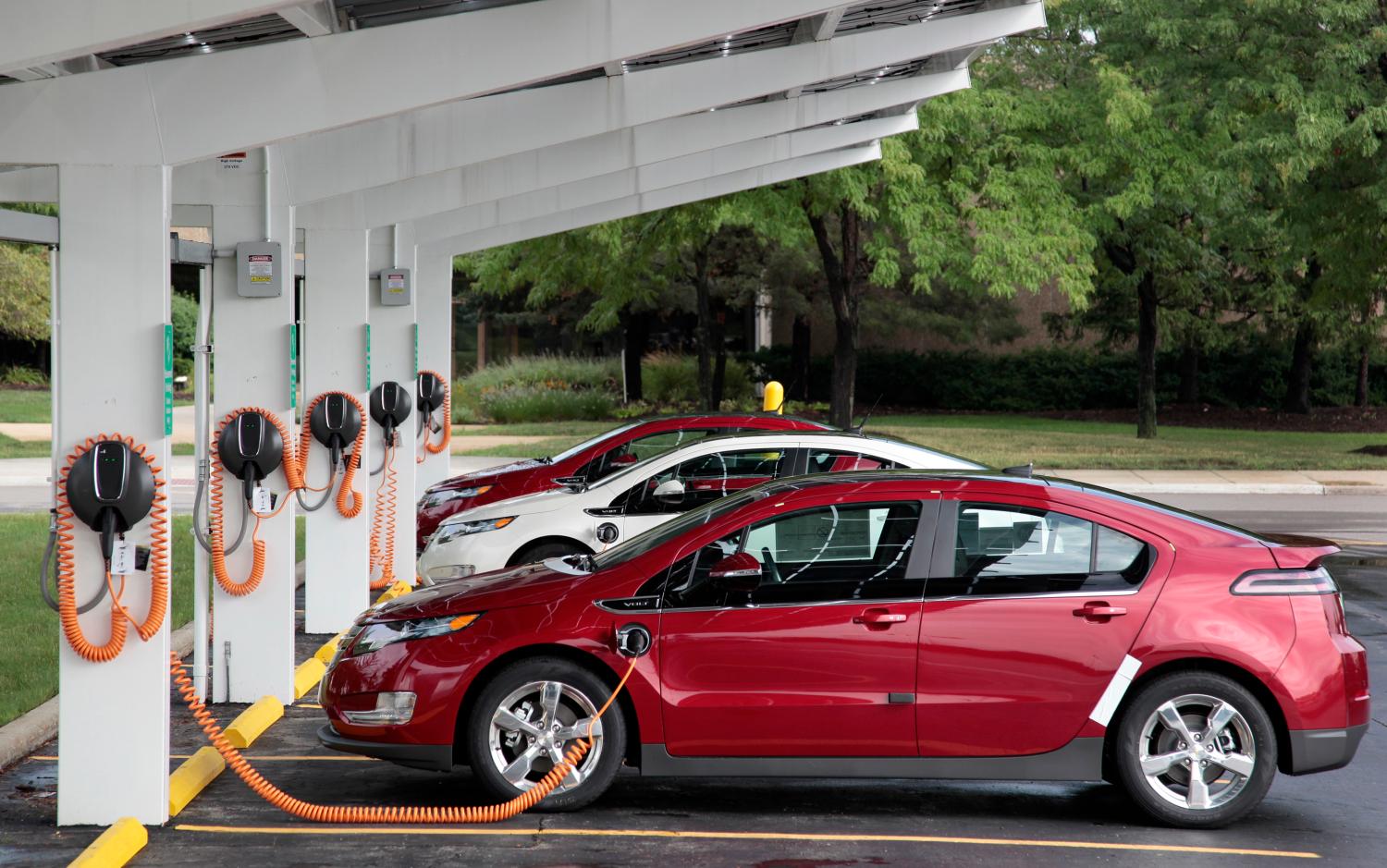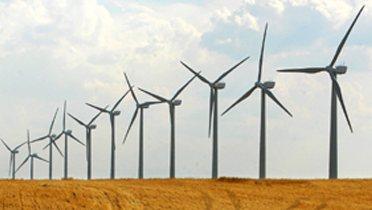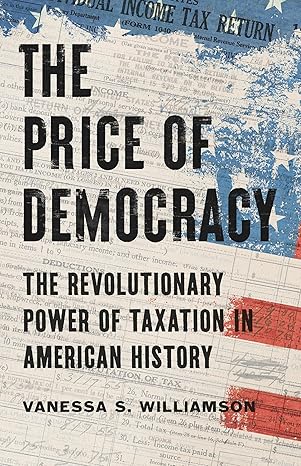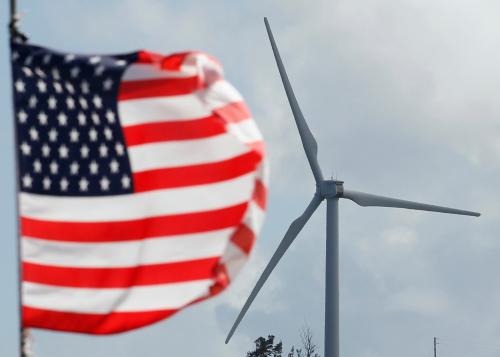Editor’s Note: During an
event
to launch a
new report
assessing the clean economy, Bruce Katz delivered a presentation highlighting the clean sector’s contribution to boosting exports and increasing manufacturing jobs. Katz’s presentation also is featured in an iBook for the iPad.
Thank you, [Brookings Managing Director] Bill [Antholis] for that introduction, and for your leadership in this institution and more broadly in the national debate on climate change.
Before proceeding, I want to first thank my colleagues, Mark Muro, Jonathan Rothwell, Devashree Saha, and our friends at Battelle, particularly Mitch Horowitz and Marty Grueber for their creativity, collegiality, and painstaking attention to detail through a long and rigorous research effort.
I’d also like to offer a special thanks to the Nathan Cummings Foundation, the General Electric Foundation, Living Cities, and the Surdna Foundation for their support and guidance of the program’s Clean Economy work, as well as the Rockefeller Foundation, who is supporting our policy and practice work around the clean economy in states and metropolitan areas.
Today, we celebrate not just the release of a report, “Sizing the Clean Economy” but the unveiling of an interactive web site to spur further research, policy and practice, all freely available at brookings-edu-2023.go-vip.net/cleaneconomy.
We want today’s forum to be a participatory event and urge all of you in the audience and following on our webcast to engage online early and often. Please comment on Twitter via the hashtag created for this event (#cleanecon) and feel free to engage directly with me at @Bruce_Katz and Mark at @MarkMuro1 and send us any questions at [email protected].
The question before us: at a time of economic uncertainty and federal polarization, can America’s cities and metropolitan areas lead the nation to a clean economy—to create jobs in the near term and retool and restructure our economy for the long haul?
There is no doubt in our minds that moving to a clean economy is an environmental and energy imperative. But consumers, companies, and cities are also sending an unequivocal signal: this is a market proposition and an economic transformation as profound as the information revolution.
Consumers around the globe are starting to demand lower carbon, energy efficient products and services: one in four drivers in the U.S., Europe, China, and Japan plans to buy electric vehicles when they are readily available. That would put about 50 million electric cars on the road in places from Baltimore to Beijing, Torino to Tokyo.
Companies see the clean economy as a growth sector: three quarters of major global corporations plan to increase “cleantech” budgets from 2012 to 2014. Global private investment in clean energy alone is up more than 6 fold since 2004, reaching $154 billion in 2010.
Cities and their metropolitan areas, early adapters of sustainable practice, are now competing to build out their special niches in the clean economy. I will provide details later on Greater Seattle’s bold strategy to be the global hub of clean IT.
For two years, the Brookings Metro Program has hammered home the notion that the United States must pursue a different growth model post recession, a “next economy” that is driven by exports, powered by low carbon, fueled by innovation and rich with opportunity—and delivered by the large metropolitan areas that drive our economy.
Today, we will literally flip the dial and place the clean economy in the center of our macro vision and unveil the scale, scope and spatial geography of this promising growth engine.
We have three sharp and timely findings.
First, the clean economy is a significant, diverse emerging market in the United States, already populated by some 2.7 million jobs. It is disproportionately manufacturing and export intensive—and offers better prospects for low and middle skilled workers than the national economy as a whole. This is exactly the kind of economy we want to build post-recession.
Second, metropolitan areas are on the vanguard of the clean economy due to their concentration of innovative drivers, as well as the built environment in which most people live, work and play. As in exports, metros specialize in different sectors of the clean economy—and the clustering of firms is catalyzing productive and sustainable growth.
Third, the U.S. must unleash the entrepreneurial energies and dynamism of our metropolitan engines to accelerate growth of the clean economy. That will require a strategic mix of private sector innovation and public policy that is stable, supportive, and predictable. Given the nature and scale of global competition, U.S. governments, at all levels, must “get in the game” rather than “get out of the way.” Smart public action can leverage private investment, create desperately needed jobs, and cement our position as the leading edge of innovative growth.
The stakes are very high. Make no mistake—we have a lot to do here and we are falling behind globally. Our competitors in mature and rising economies—Germany, Japan, and China—fully understand the potential of clean, and they are working at warp speed to set favorable conditions for rapid growth and grab their share of the next market revolution. We need to get our public-private act together—in cities and metros, in state capitals, at the now polarized federal level.
So let’s start with our first finding: the clean economy is a significant, diverse emerging market in the United States
In total, we find there are 2.7 million clean economy jobs all across the United States. To put that number in perspective: the clean economy is nearly twice the size of the biosciences field and 60 percent of the 4.8 million strong IT sector. As you can tell, the clean economy also has more jobs than fossil fuel related industries.
Our definition of the clean economy is as follows:
“Any economic activity—measured in terms of establishments and jobs—that produces goods and services with an environmental benefit, or adds value to such products using skills or technologies that are uniquely applied to those products.”
This definition yields a broad and varied picture of economic activity: old and new, public and private, “green” and “blue.”
At the highest level, we find establishments and jobs grouping together in 5 discernible categories: Renewable Energy; Energy and Resource Efficiency; Greenhouse Gas Reduction; Environmental Management, and Recycling; Agricultural and Natural Resources Conservation; and Education and Compliance. Here we follow the categorization the Bureau of Labor Statistics is using for its own “green jobs” assessment due next year.
These categories then naturally break down into fine-grained segments, ultimately 39 in all.
Renewable Energy, for example, has nine segments, including Solar and Geothermal power, and Renewable Energy Services.
Energy and Resource Efficiency has 13 separate segments, from Electric Vehicle Technology to Water Efficient Products.
Greenhouse Gas Reduction, Environmental Management, and Recycling has 12 segments including Green Chemical Products and Professional Environmental Services.
And so on—you get the idea.
Each of the segments, in turn, has a distinct economic profile (cutting across multiple activities, occupations and skills) and a distinct spatial geography given the special assets and attributes of different places.
Let’s drill down a little so we all get on the same page.
Under renewable energy, let’s look at solar photovoltaic, a young rapidly innovating area. This segment employs more than 24,000 people in 555 establishments.
The list includes two major solar manufacturing firms, First Solar—with a major plant in Toledo—and BP Solar—with a facility in the Washington, DC metro, and Bombard Electric in Las Vegas, which helps businesses in that region—casinos, hotels, shopping centers—shift their energy use.
Under Greenhouse Gas Reduction, let’s take a look at Professional Environmental Services, an example of the role that expert services can play in domestic and global markets. This segment boasts some 140,000 workers in 5,400 establishments.
CH2M Hill in Denver provides environmental consulting services throughout the U.S. and the world, Ecology & Environment is a science and technical services firm with a large presence in Los Angeles, and Black & Veatch, out of Kansas City, is an engineering firm specializing in areas from environmental permitting to remediation.
One more definitional cut to consider: we have identified a group of young, super innovative “Cleantech” industries that cross multiple categories and show enormous growth potential. These industries are populated by companies with a median age of 15 years or less.
Most notably, this portfolio of segments—including wind power, battery technologies, bio fuels, and smart grid—grew about 8 percent a year since 2003, or twice as fast as the rest of the economy.
The clean economy, however, is not just broad and diverse, it is disproportionately productive.
The clean economy is export intensive, already taking advantage of the demand for clean goods and services coming from abroad.
In 2009, clean economy establishments exported almost $54 billion, including about $49.5 billion in goods and an additional $4.5 billion in services.
Significantly, clean economy establishments are by our calculations twice as export intensive as the national economy: over $20,000 worth of exports is sold for every job in the clean economy each year compared to just $10,400 worth of exports for the average U.S. job.
The export orientation of the clean economy today provides a platform for more exports tomorrow. With rising nations rapidly urbanizing, the demand for sustainable growth in all its dimensions will only grow, and the U.S. has the potential to serve that demand.
The clean economy also supports a production-driven innovation economy.
We find it employs a higher percentage of scientists than the national economy. Ten percent of clean economy jobs are in science and engineering, compared to 5 percent in U.S. economy generally.
As we now know, manufacturing and innovation are inextricably linked. This provides a stark challenge to the U.S.: we will innovate less unless we produce more.
By our account, the clean economy is a vehicle for production.
Twenty six percent of all clean economy jobs are involved in manufacturing, compared to just 9 percent of jobs in the economy as a whole.
Manufacturing accounts for a majority of the jobs in over half of the clean economy segments, with many sectors having a supermajority of production-oriented jobs.
Solar and wind energy, for example, have more than two thirds of their jobs in manufacturing. And some segments, including appliances, water efficient products, and electric vehicle technologies have over 90 percent of their jobs in manufacturing.
The good news: clean manufacturing is growing, even in the face of national declines in manufacturing employment.
Finally, the clean economy is opportunity rich, providing prospects for a wide range of workers, and good wages up and down the skills ladder.
The clean economy is easy to enter, available to people of all skill levels: 45 percent of all clean jobs are held by workers with a high school diploma or less, compared to only 37 percent of U.S. jobs.
Once a worker enters the field, he or she is more likely to receive career-building training, as 41 percent of clean jobs offer medium to long-term training, compared to 23 percent of U.S. jobs.
The payoff is higher wages: the median wage in the clean economy is almost $44,000 for the average occupation, significantly higher than the national equivalent of $38,000 and change.
In summary, the clean economy is the kind of economy we want to build: export oriented, innovation fueled, opportunity rich, and balanced.
So here is our second major finding, metros are on the vanguard of the clean economy
Here is the heart of the American economy: 100 metropolitan areas that after decades of growth take up only 12 percent of our land mass, but harbor two-thirds of our population and generate 75 percent of our gross domestic product.
These communities form a new economic geography, enveloping cities and suburbs, exurbs and rural towns.
Our research shows the extent to which these top 100 metros, in the aggregate, are driving growth in the Clean Economy.
In 2010, they constitute an increasing share of clean economy jobs, almost 64 percent.
And they include an outsized share, 74 percent, of jobs in cleantech industries, including extraordinarily high shares in solar photovoltaic, battery technologies, smart grid, and wind energy.
Innovative clean jobs are predominately in the top 100 metros because these places concentrate the assets that drive innovation, from initial research through commercialization through ultimate deployment
The major metros are also leading the growth of clean economy jobs around the built environment. They harbor 78 percent of jobs in public mass transit, and 90 percent of the jobs in green architecture, design and construction since moving people more efficiently and making buildings energy efficient will primarily be a metropolitan act, given where most people live and travel, and businesses locate.
Incredibly, metros also include a decent share of clean jobs that are traditionally rural, with at least 23 percent of jobs in resource-intensive activities like hydropower, sustainable forestry products, and biofuels, and more than half of organic food and farming jobs.
Metro economies, of course, do not exist in the aggregate; they have distinctive starting points and distinctive assets, attributes and advantages.
Our research digs deep to profile the clean economy potential of each of the top 100 metro areas.
Four metro areas—New York, L.A., Chicago and Washington—are supersized job centers, with more than 70,000 jobs apiece in the clean economy in 2010. The New York metro alone has more than 152,000 clean economy jobs.
Other major metros—Philadelphia, San Francisco, Atlanta, Boston, Houston and Dallas—are also key players, with more than 38,000 jobs apiece as of that year.
Yet this is not just about the largest metros. As we see here, a different group of small and medium sized metros have more than 3.3 percent of their jobs situated in the clean economy. Albany leads the way, with an impressive 6.3 percent of its jobs in the clean economy.
The power of metros is the power of agglomeration, networks and clusters.
Our report finds that clusters—the proximity of firms to businesses in related industries—boost metros’ growth performance in the clean economy, and metros facilitate clustering.
Examples include professional environmental services in Houston, solar photovoltaic in Los Angeles, fuel cells in Boston, wind in Chicago, water industries in Milwaukee, and energy efficiency in Philadelphia.
We can talk about clusters in the abstract, but its best to see them in practice from the ground up.
So let’s travel to the Philadelphia metropolis—the nation’s fifth largest—which includes the city of Philadelphia and surrounding counties.
Philadelphia is the fifth largest clean economy job center in the country.
Here we can find the advanced research engines of the University of Pennsylvania and Drexel in University City, who have partnered together on clean energy research and have provided a steady stream of talented workers to public, private and nonprofit firms and intermediaries.
These universities are part of the Greater Philadelphia Innovation Cluster, based at the Navy Yard, on the Delaware River. This consortium received $129 million in federal funding from multiple agencies to demonstrate the efficacy of new building energy efficient components, systems and models.
The consortium includes strong support of City Hall, led by Mayor Michael Nutter, who has pioneered smart skills training in the energy efficient sector as well as the Philadelphia Industrial Development Corporation, which has been an investor in the Navy Yard.
And then, of course, there are firms and companies, the fuel of the economy, located throughout the Philadelphia metropolis.
Downtown we find Veridity Energy, a small smart grid firm with powerful technology tools. The density of Center City supports a healthy mix of highly skilled service firms. Just around the corner is Realwinwin, which provides finance services to companies making capital investments in energy efficiency.
But metropolitan economies cross city and county borders because different kinds of firms require different urban and suburban footprints—so if we look out to the suburb of Radnor, just past Bryn Mawr and I-476, we find Iberdrola, the second largest wind operator in the United States and a subsidiary of a major Spanish renewable energy company and an example of the wave of foreign direct investment that can help the U.S. build out the clean economy.
The Philadelphia story reveals why cities and metro areas power our economy: they are hyper linked networks of private firms and public and nonprofit institutions that fertilize ideas, share workers, extend innovation, enhance competitiveness and catalyze growth.
Which leads to our final proposition: to build the next economy the U.S. must unleash the entrepreneurial energies and dynamism of our metropolitan engines.
We compete in a fiercely competitive world.
While America continues to debate the legitimacy of global warming research, our competitors in established nations like Germany, Japan and the U.K. and rising nations like China are taking transformative steps to grow their clean economies in the precise places—Munich, Tokyo, London, Shanghai—that drive their national economies.
The United States can compete with these and other nations. No other nation can match us in domestic demand, advanced research, venture capital, the power of metro concentration.
But our potential will not be realized unless we provide a strong policy platform for the build out of the clean economy.
Four steps are essential:
Step one: scale-up markets by catalyzing demand for clean economy goods and services.
Step two: drive innovation by investing in advanced R&D at scale, over a sustained period and via new distributed networks.
Step three: catalyze finance to produce and deploy more of what we invent.
And step four: align with cities and metros to realize the synergies of clustering and place.
Our competitors know that economy shaping of this magnitude should start at the national scale.
And so, in a perfect world, we would have our federal government create a framework for growth and success.
We have seen some of that leadership in the past few years, through: the procurement driven, market scaling efforts of the Department of Defense, the creation of new innovation vehicles like ARPA-E, some of the financial investments of the Department of Energy’s Loan Guarantee Program, and the metro-supporting investments in new energy regional innovation clusters—like the Greater Philadelphia example—supported by agencies with diverse sets of missions and resources, including DOE, Commerce, Labor, Education, and SBA.
But with our global competitors continuously upping their goals and expanding their commitments, we desperately need our federal government to go further and act with vision and ambition and consistency.
To scale-up markets, Congress should enact a national clean energy standard (CES) that signals a long term, consistent commitment to alternative energy sources.
To drive innovation, Congress should embrace the call by the American Energy Innovation Council, led by corporate titans like Bill Gates and Jeff Immelt, to invest $16 billion annually in clean energy research and development through ARPA-E and networks of institutions that are multi-disciplinary and engage seamlessly with the private sector.
To catalyze finance, Congress should authorize a technology deployment finance entity—a Green Bank for short—to provide finance of the right scale and risk tolerance to ensure that ideas generated in America lead to products made in America.
Congress should also rationalize, reform, and selectively extend the myriad tax provisions and incentives that currently support the clean economy but which are now chaotic, unstable, inconsistent, and obtuse about evoking innovation and steady price declines from maturing clean technologies.
And to align with regions, Congress should more than double the number of energy innovation hubs and clusters that are seeded and funded.
Frankly, it is not difficult to lay out what reforms and investments are needed to grow the clean economy. Our competitors have given us clear guidance on that score. The only issue is whether our federal government, riven by excessive partisanship and ideological polarization, can muster the will to get anything done.
Fortunately in the U.S. we have a default proposition when our national government falters, our states act as our “laboratories of democracy” and, as California Lt. Governor Gavin Newsom recently observed, our cities and metros act as the laboratories of innovation.
And so that’s how, for the time being, we will need to build our clean economy in the United States, the hard way, from the ground up.
The good news: there is no shortage of policy innovation and political commitment at the state and metro scale.
To scale up markets, California has set an aggressive renewable portfolio standard of 33 percent renewable energy by 2020. With this strong foundation, San Jose and other cities and counties are doing their part to facilitate consumer adoption: streamlining or even eliminating building permitting for solar panels.
To drive innovation, Wisconsin has created the School of Freshwater Sciences at the University of Wisconsin-Milwaukee to leverage that metro’s rising position in the blue economy. The Milwaukee Water Council is building on this, spearheading a network of scientists and companies to realize Milwaukee’s ambition to be a global hub for freshwater research, firm creation, and business expansion.
To catalyze finance, Connecticut recently created the Connecticut Clean Energy Finance and Investment Authority. Capitalized with some $50 million annually, this Green Bank could accelerate the generation, transmission, and adoption of alternative energy.
At the municipal level, New York City has capitalized an Energy Efficiency Corporation to spur the financing of energy efficiency in the building sector.
And, finally, smart metros are now moving to build out their distinctive industry clusters. In Greater Seattle, for example, the Puget Sound Regional Council has developed a business plan to cement that metro’s natural position as a global hub of energy efficient building technologies. This smart public-private initiative includes the establishment of a facility to test, integrate and verify promising energy efficient products and services before launching them to market.
Significantly, this metro vision is being supported by the State of Washington, which has committed to match any federal investment in the testing network.
Let me conclude with this vision: Let’s imagine a world in 20 years where the clean economy permeates every aspect of our economic and social fabric and, in the process, enhances productivity and competitiveness, lowers energy use, spurs further innovation, and provides quality work for a broad cross section of our citizenry.
We believe today’s research—and the power of millions of consumers, tens of thousands of companies and hundreds of cities and metros—gives us the hope that this vision can become reality.
We have the data to set a platform for sustainable growth.
We have the roadmap to set the foundation for smart investment.
We have the entrepreneurs in all sectors to innovate and replicate.
Let’s build the clean economy—worker by worker, firm by firm, metro by metro.
Thank you.
The Brookings Institution is committed to quality, independence, and impact.
We are supported by a diverse array of funders. In line with our values and policies, each Brookings publication represents the sole views of its author(s).







Commentary
Sizing the Clean Economy: Remarks by Bruce Katz
July 13, 2011